Abstract
Spontaneous lymphocyte proliferation (SLP) during in vitro culture of mononuclear cells (MCs) characterizes over half of asymptomatic individuals infected with human T-cell lymphotropic virus type I (HTLV-I) or HTLV-II. Both CD4 and CD8 T-cell subsets within MC cultures are activated during SLP, as judged by high-density CD25 (CD25bright) expression; it is unclear, however, whether both cell subsets can directly undergo SLP. In the present investigation, the SLP capacities of purified CD8 and CD4 cells were examined in subjects infected with HTLV-I (n = 19) or HTLV-II (n = 54) in relation to the SLP status of MCs from each subject. No increase in SLP was observed for CD8 or CD4 cells from SLP-negative (SLP-) HTLV-infected subjects, whereas robust SLP characterized CD8 cells from all SLP-positive (SLP+) individuals, regardless of HTLV type. In contrast, SLP+ CD4 cells characterized only 23% (7 of 31) of HTLV-II+ SLP+ individuals, whereas SLP+ CD4 cells characterized 100% of HTLV-I+ SLP+ individuals. In cocultures of HTLV-II+ SLP+ CD8 cells and autologous SLP- CD4 cells, sizable proportions of both CD8 cells and CD4 cells coexpressed CD25bright, suggesting that SLP- CD4 cells were activated in the presence of SLP+ CD8 cells. PCR analysis for tax sequences detected provirus in most CD4- and CD8-cell preparations from HTLV-seropositive individuals, regardless of type and the SLP status of cell subsets. To determine whether SLP was associated with activation of viral genes, levels of HTLV-I and HTLV-II core antigen (Ag) in supernatants were measured. Viral Ag production and SLP responses were significantly correlated for both CD4 and CD8 cells in both HTLV-I and HTLV-II infections. However, inhibition of CD8- or CD4-cell SLP by cyclosporin A or anti-Tac (anti-CD25) did not reduce Ag production, indicating that Ag production is not coupled to SLP. These findings show that CD4 cells from SLP+ HTLV-I+ and SLP+ HTLV-II+ individuals differ in SLP capacity, that the absence of SLP does not indicate a lack of infection, and that production of viral Ag is associated with, but not dependent on, SLP.
Full text
PDF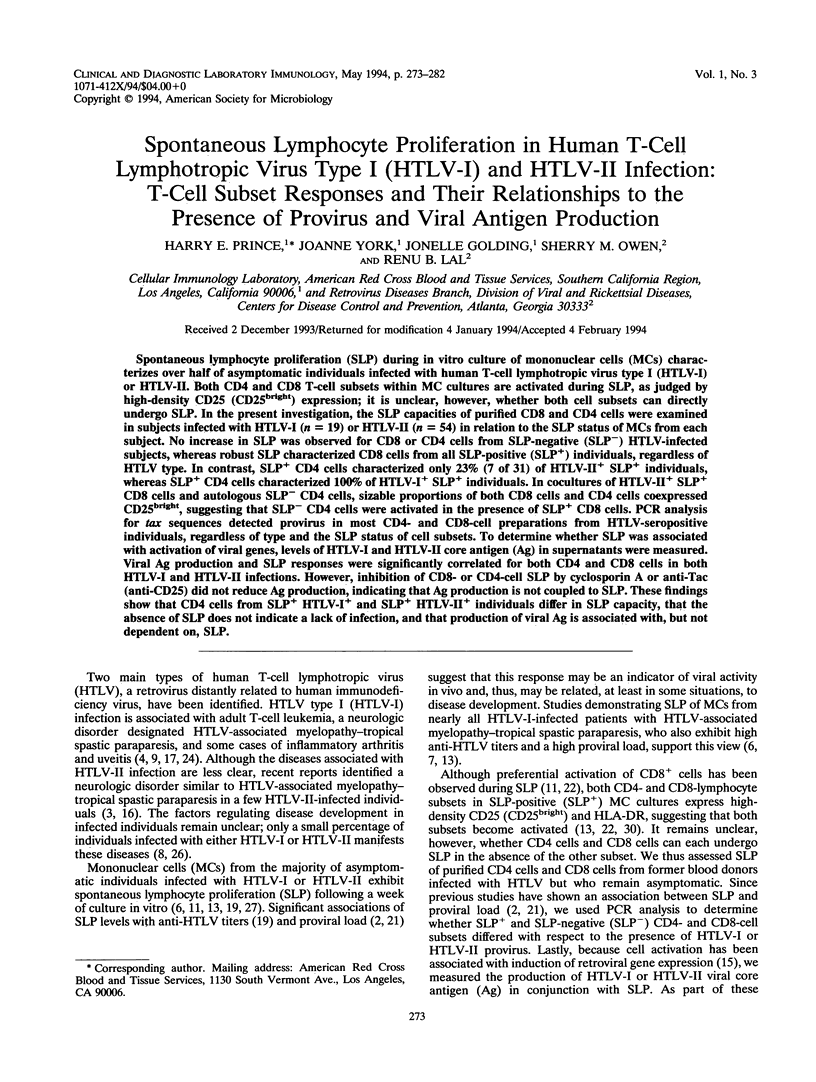
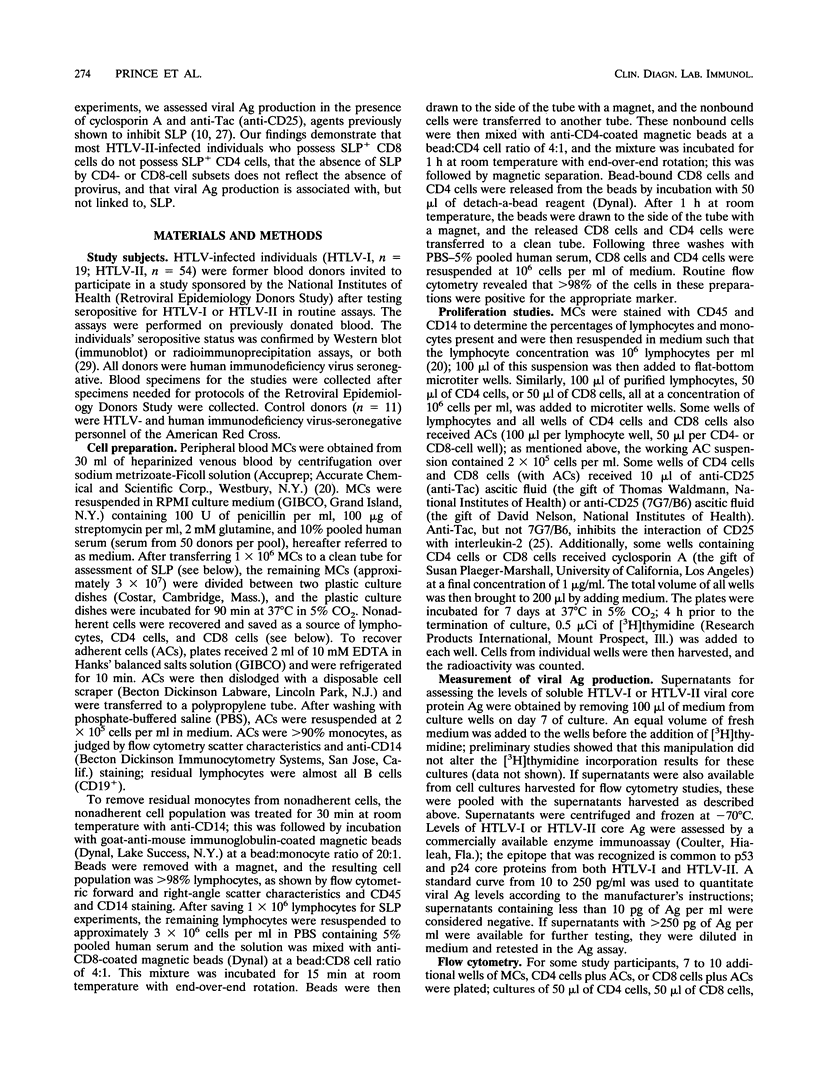
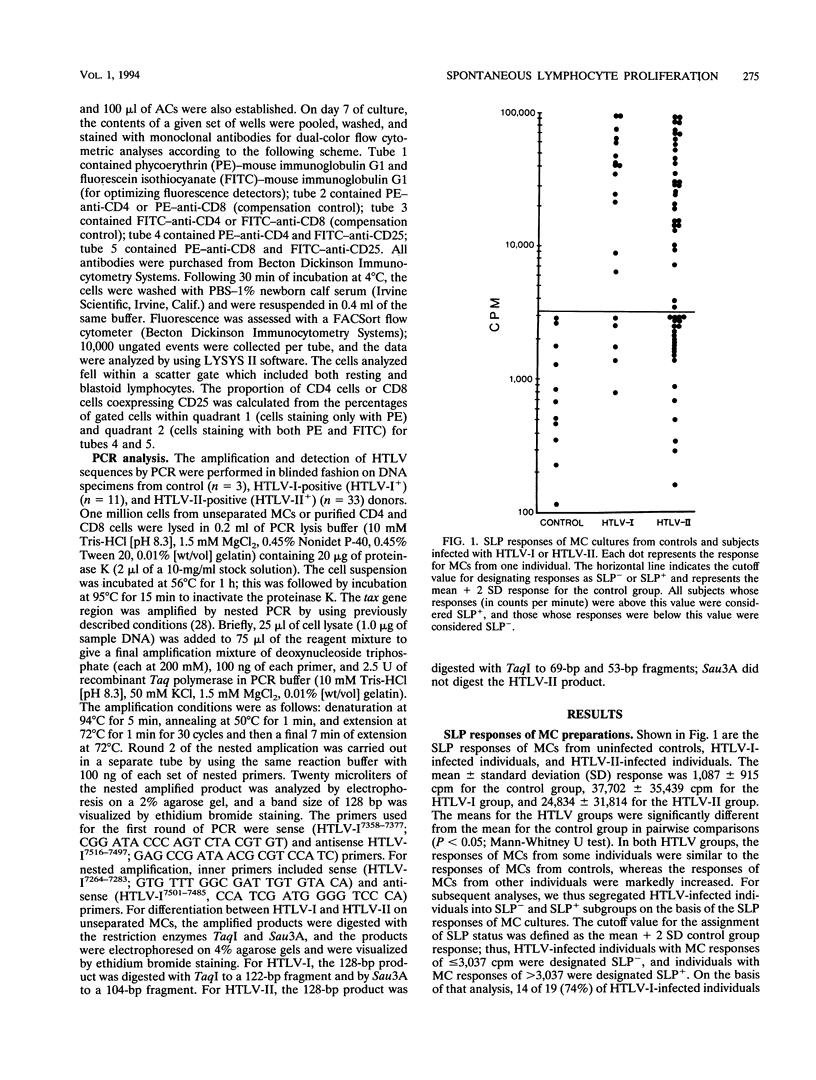
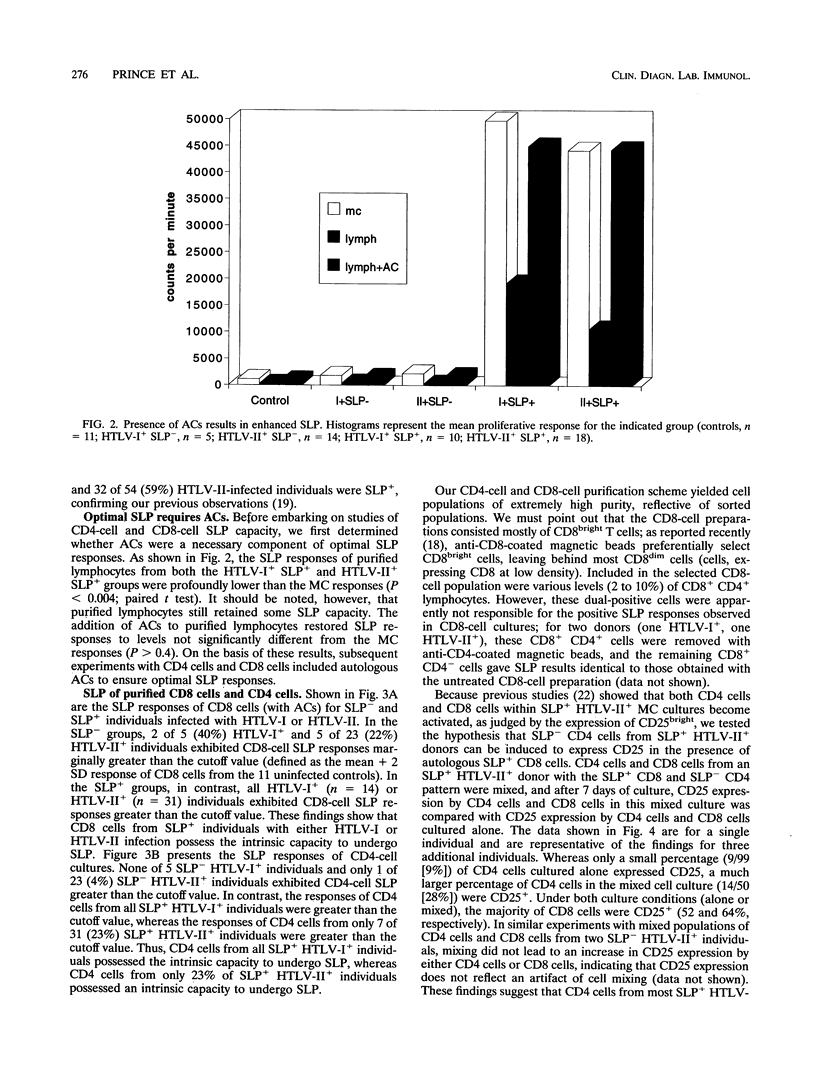
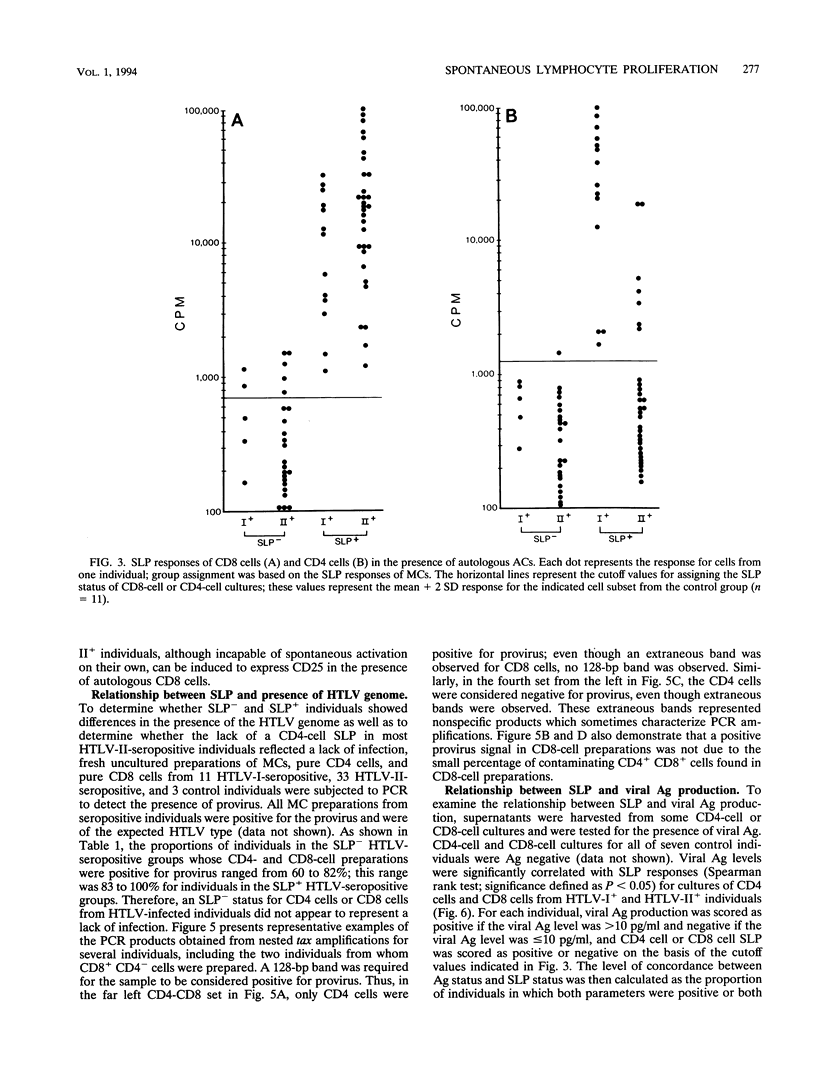
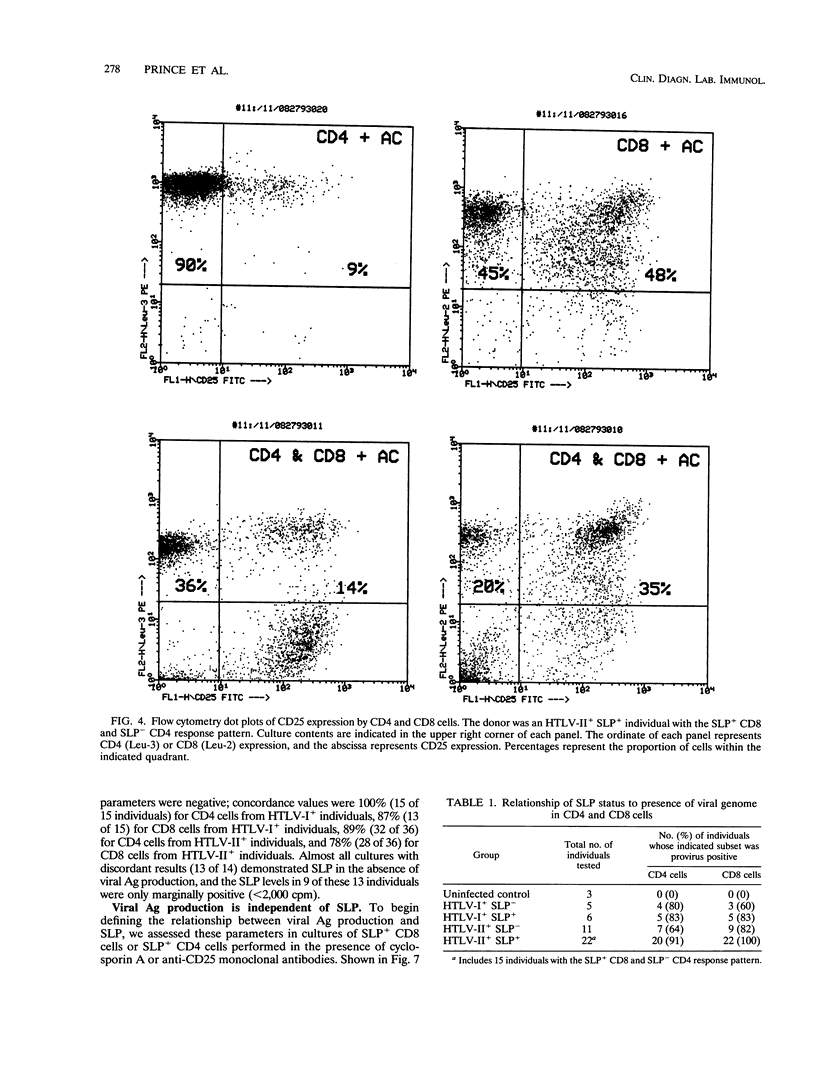
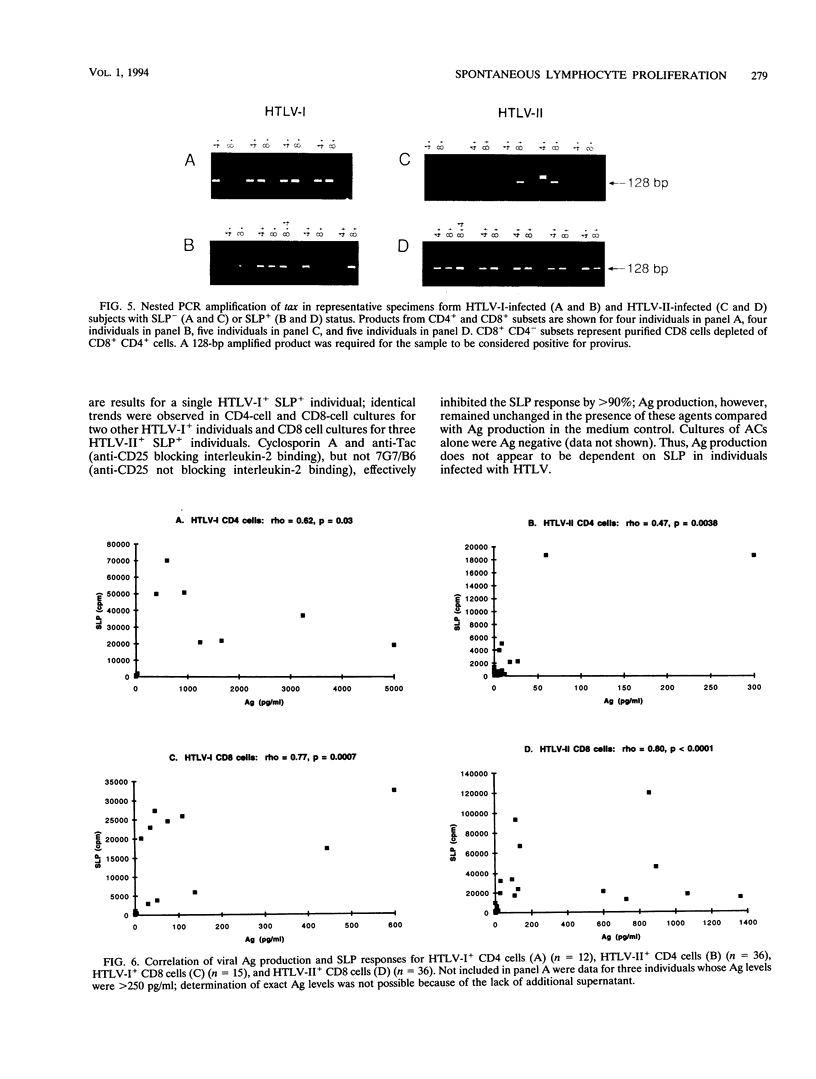
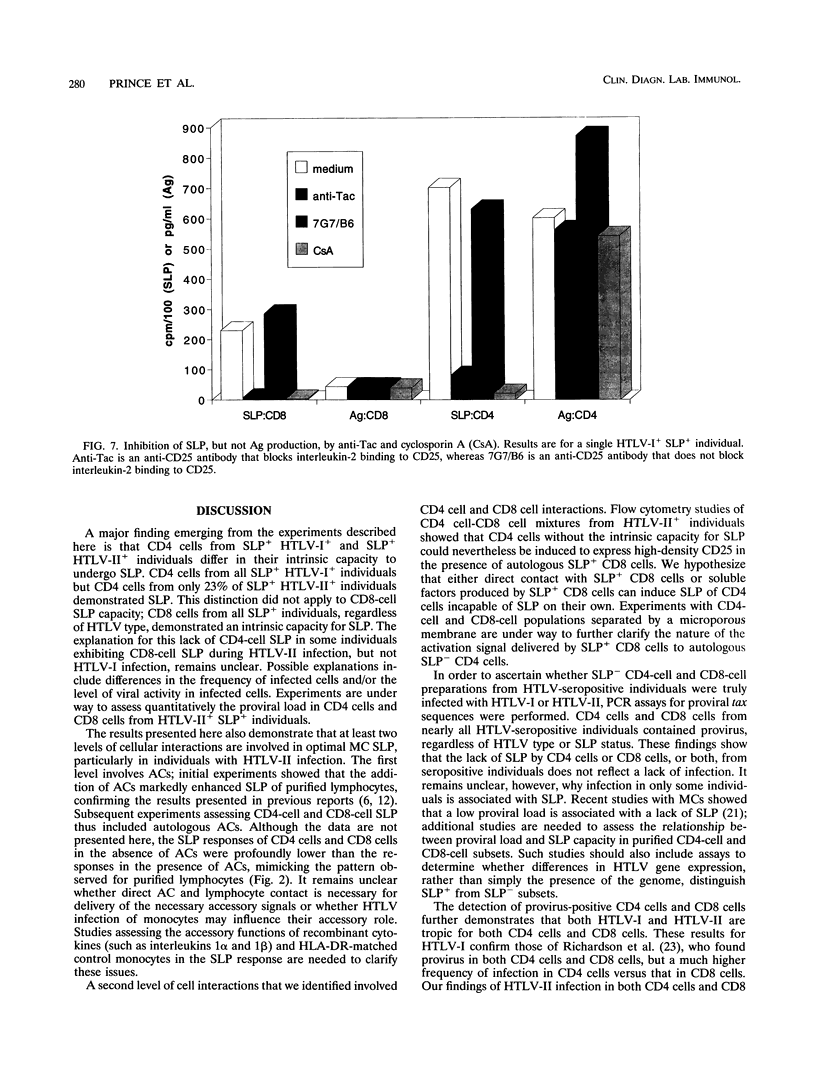
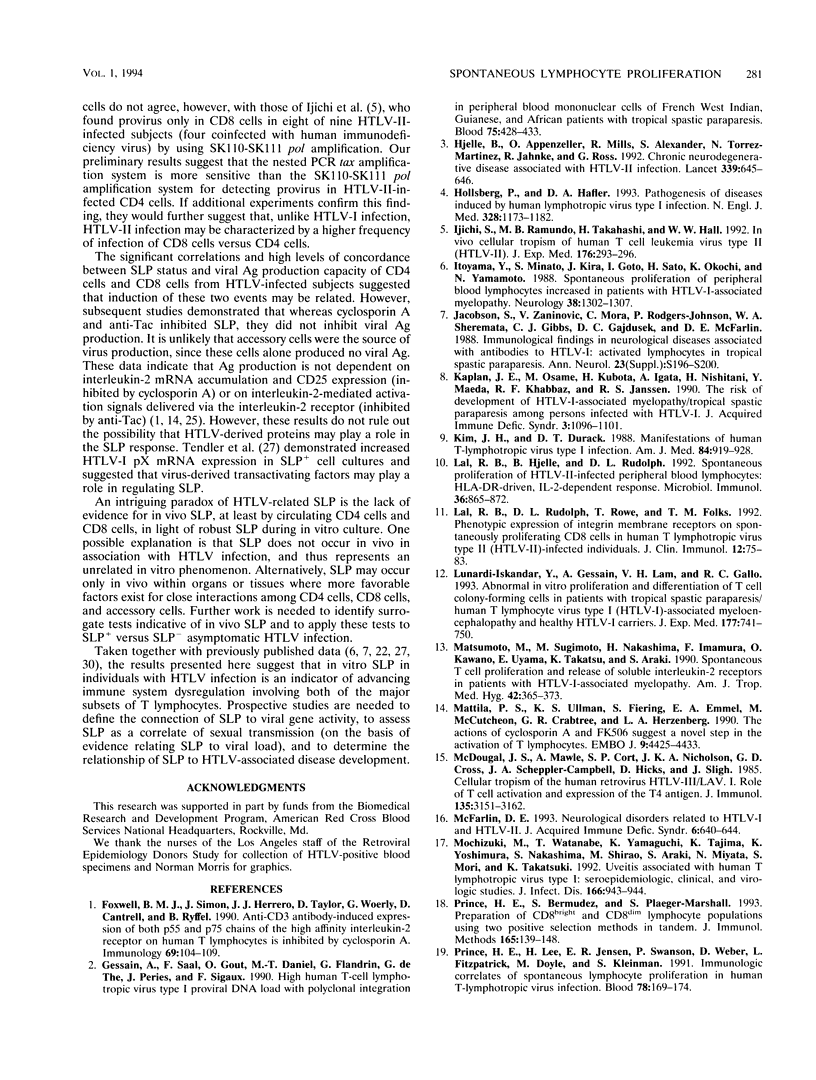
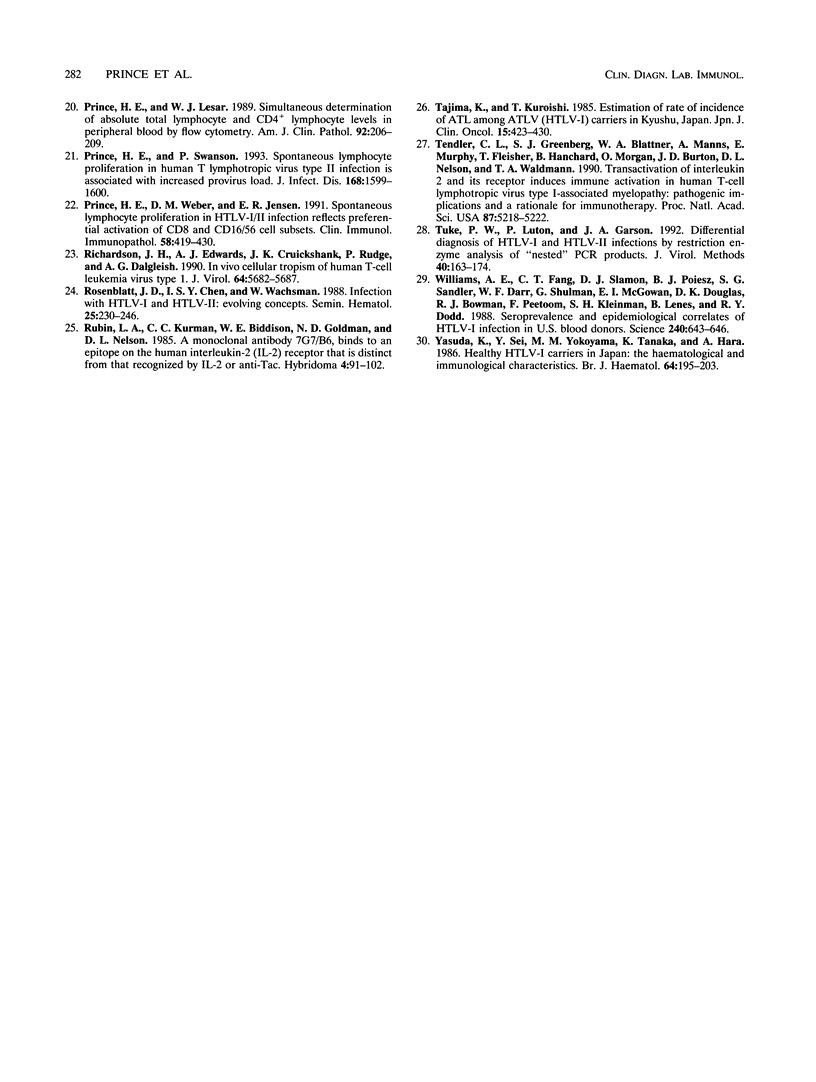
Images in this article
Selected References
These references are in PubMed. This may not be the complete list of references from this article.
- Foxwell B. M., Simon J., Herrero J. J., Taylor D., Woerly G., Cantrell D., Ryffel B. Anti-CD3 antibody-induced expression of both p55 and p75 chains of the high affinity interleukin-2 receptor on human T lymphocytes is inhibited by cyclosporin A. Immunology. 1990 Jan;69(1):104–109. [PMC free article] [PubMed] [Google Scholar]
- Gessain A., Saal F., Gout O., Daniel M. T., Flandrin G., de The G., Peries J., Sigaux F. High human T-cell lymphotropic virus type I proviral DNA load with polyclonal integration in peripheral blood mononuclear cells of French West Indian, Guianese, and African patients with tropical spastic paraparesis. Blood. 1990 Jan 15;75(2):428–433. [PubMed] [Google Scholar]
- Hjelle B., Appenzeller O., Mills R., Alexander S., Torrez-Martinez N., Jahnke R., Ross G. Chronic neurodegenerative disease associated with HTLV-II infection. Lancet. 1992 Mar 14;339(8794):645–646. doi: 10.1016/0140-6736(92)90797-7. [DOI] [PubMed] [Google Scholar]
- Höllsberg P., Hafler D. A. Seminars in medicine of the Beth Israel Hospital, Boston. Pathogenesis of diseases induced by human lymphotropic virus type I infection. N Engl J Med. 1993 Apr 22;328(16):1173–1182. doi: 10.1056/NEJM199304223281608. [DOI] [PubMed] [Google Scholar]
- Ijichi S., Ramundo M. B., Takahashi H., Hall W. W. In vivo cellular tropism of human T cell leukemia virus type II (HTLV-II). J Exp Med. 1992 Jul 1;176(1):293–296. doi: 10.1084/jem.176.1.293. [DOI] [PMC free article] [PubMed] [Google Scholar]
- Itoyama Y., Minato S., Kira J., Goto I., Sato H., Okochi K., Yamamoto N. Spontaneous proliferation of peripheral blood lymphocytes increased in patients with HTLV-I-associated myelopathy. Neurology. 1988 Aug;38(8):1302–1307. doi: 10.1212/wnl.38.8.1302. [DOI] [PubMed] [Google Scholar]
- Jacobson S., Zaninovic V., Mora C., Rodgers-Johnson P., Sheremata W. A., Gibbs C. J., Jr, Gajdusek C., McFarlin D. E. Immunological findings in neurological diseases associated with antibodies to HTLV-I: activated lymphocytes in tropical spastic paraparesis. Ann Neurol. 1988;23 (Suppl):S196–S200. doi: 10.1002/ana.410230744. [DOI] [PubMed] [Google Scholar]
- Kaplan J. E., Osame M., Kubota H., Igata A., Nishitani H., Maeda Y., Khabbaz R. F., Janssen R. S. The risk of development of HTLV-I-associated myelopathy/tropical spastic paraparesis among persons infected with HTLV-I. J Acquir Immune Defic Syndr. 1990;3(11):1096–1101. [PubMed] [Google Scholar]
- Kim J. H., Durack D. T. Manifestations of human T-lymphotropic virus type I infection. Am J Med. 1988 May;84(5):919–928. doi: 10.1016/0002-9343(88)90072-1. [DOI] [PubMed] [Google Scholar]
- Lal R. B., Hjelle B., Rudolph D. L. Spontaneous proliferation of HTLV-II-infected peripheral blood lymphocytes: HLA-DR-driven, IL-2-dependent response. Microbiol Immunol. 1992;36(8):865–872. doi: 10.1111/j.1348-0421.1992.tb02088.x. [DOI] [PubMed] [Google Scholar]
- Lal R. B., Rudolph D. L., Rowe T., Folks T. M. Phenotypic expression of integrin membrane receptors on spontaneously proliferating CD8 cells in human T-lymphotropic virus type II (HTLV-II)-infected individuals. J Clin Immunol. 1992 Mar;12(2):75–83. doi: 10.1007/BF00918136. [DOI] [PubMed] [Google Scholar]
- Lunardi-Iskandar Y., Gessain A., Lam V. H., Gallo R. C. Abnormal in vitro proliferation and differentiation of T cell colony-forming cells in patients with tropical spastic paraparesis/human T lymphocyte virus type I (HTLV-I)-associated myeloencephalopathy and healthy HTLV-I carriers. J Exp Med. 1993 Mar 1;177(3):741–750. doi: 10.1084/jem.177.3.741. [DOI] [PMC free article] [PubMed] [Google Scholar]
- Matsumoto M., Sugimoto M., Nakashima H., Imamura F., Kawano O., Uyama E., Takatsu K., Araki S. Spontaneous T cell proliferation and release of soluble interleukin-2 receptors in patients with HTLV-I-associated myelopathy. Am J Trop Med Hyg. 1990 Apr;42(4):365–373. doi: 10.4269/ajtmh.1990.42.365. [DOI] [PubMed] [Google Scholar]
- Mattila P. S., Ullman K. S., Fiering S., Emmel E. A., McCutcheon M., Crabtree G. R., Herzenberg L. A. The actions of cyclosporin A and FK506 suggest a novel step in the activation of T lymphocytes. EMBO J. 1990 Dec;9(13):4425–4433. doi: 10.1002/j.1460-2075.1990.tb07893.x. [DOI] [PMC free article] [PubMed] [Google Scholar]
- McFarlin D. E. Neurological disorders related to HTLV-I and HTLV-II. J Acquir Immune Defic Syndr. 1993 Jun;6(6):640–644. [PubMed] [Google Scholar]
- Mochizuki M., Watanabe T., Yamaguchi K., Tajima K., Yoshimura K., Nakashima S., Shirao M., Araki S., Miyata N., Mori S. Uveitis associated with human T lymphotropic virus type I: seroepidemiologic, clinical, and virologic studies. J Infect Dis. 1992 Oct;166(4):943–944. doi: 10.1093/infdis/166.4.943. [DOI] [PubMed] [Google Scholar]
- Prince H. E., Bermudez S., Plaeger-Marshall S. Preparation of CD8bright and CD8dim lymphocyte populations using two positive selection methods in tandem. J Immunol Methods. 1993 Oct 15;165(2):139–148. doi: 10.1016/0022-1759(93)90339-9. [DOI] [PubMed] [Google Scholar]
- Prince H. E., Lee H., Jensen E. R., Swanson P., Weber D., Fitzpatrick L., Doyle M., Kleinman S. Immunologic correlates of spontaneous lymphocyte proliferation in human T-lymphotropic virus infection. Blood. 1991 Jul 1;78(1):169–174. [PubMed] [Google Scholar]
- Prince H. E., Lesar W. J. Simultaneous determination of absolute total lymphocyte and CD4+ lymphocyte levels in peripheral blood by flow cytometry. Am J Clin Pathol. 1989 Aug;92(2):206–209. doi: 10.1093/ajcp/92.2.206. [DOI] [PubMed] [Google Scholar]
- Prince H. E., Swanson P. Spontaneous lymphocyte proliferation in human T lymphotropic virus type II infection is associated with increased provirus load. J Infect Dis. 1993 Dec;168(6):1599–1600. doi: 10.1093/infdis/168.6.1599. [DOI] [PubMed] [Google Scholar]
- Prince H. E., Weber D. M., Jensen E. R. Spontaneous lymphocyte proliferation in HTLV-I/II infection reflects preferential activation of CD8 and CD16/56 cell subsets. Clin Immunol Immunopathol. 1991 Mar;58(3):419–430. doi: 10.1016/0090-1229(91)90132-t. [DOI] [PubMed] [Google Scholar]
- Richardson J. H., Edwards A. J., Cruickshank J. K., Rudge P., Dalgleish A. G. In vivo cellular tropism of human T-cell leukemia virus type 1. J Virol. 1990 Nov;64(11):5682–5687. doi: 10.1128/jvi.64.11.5682-5687.1990. [DOI] [PMC free article] [PubMed] [Google Scholar]
- Rosenblatt J. D., Chen I. S., Wachsman W. Infection with HTLV-I and HTLV-II: evolving concepts. Semin Hematol. 1988 Jul;25(3):230–246. [PubMed] [Google Scholar]
- Rubin L. A., Kurman C. C., Biddison W. E., Goldman N. D., Nelson D. L. A monoclonal antibody 7G7/B6, binds to an epitope on the human interleukin-2 (IL-2) receptor that is distinct from that recognized by IL-2 or anti-Tac. Hybridoma. 1985 Summer;4(2):91–102. doi: 10.1089/hyb.1985.4.91. [DOI] [PubMed] [Google Scholar]
- Tajima K., Kuroishi T. Estimation of rate of incidence of ATL among ATLV (HTLV-I) carriers in Kyushu, Japan. Jpn J Clin Oncol. 1985 Jun;15(2):423–430. [PubMed] [Google Scholar]
- Tendler C. L., Greenberg S. J., Blattner W. A., Manns A., Murphy E., Fleisher T., Hanchard B., Morgan O., Burton J. D., Nelson D. L. Transactivation of interleukin 2 and its receptor induces immune activation in human T-cell lymphotropic virus type I-associated myelopathy: pathogenic implications and a rationale for immunotherapy. Proc Natl Acad Sci U S A. 1990 Jul;87(13):5218–5222. doi: 10.1073/pnas.87.13.5218. [DOI] [PMC free article] [PubMed] [Google Scholar]
- Tuke P. W., Luton P., Garson J. A. Differential diagnosis of HTLV-I and HTLV-II infections by restriction enzyme analysis of 'nested' PCR products. J Virol Methods. 1992 Nov;40(2):163–173. doi: 10.1016/0166-0934(92)90065-l. [DOI] [PubMed] [Google Scholar]
- Williams A. E., Fang C. T., Slamon D. J., Poiesz B. J., Sandler S. G., Darr W. F., 2nd, Shulman G., McGowan E. I., Douglas D. K., Bowman R. J. Seroprevalence and epidemiological correlates of HTLV-I infection in U.S. blood donors. Science. 1988 Apr 29;240(4852):643–646. doi: 10.1126/science.2896386. [DOI] [PubMed] [Google Scholar]
- Yasuda K., Sei Y., Yokoyama M. M., Tanaka K., Hara A. Healthy HTLV-I carriers in Japan: the haematological and immunological characteristics. Br J Haematol. 1986 Sep;64(1):195–203. doi: 10.1111/j.1365-2141.1986.tb07587.x. [DOI] [PubMed] [Google Scholar]



